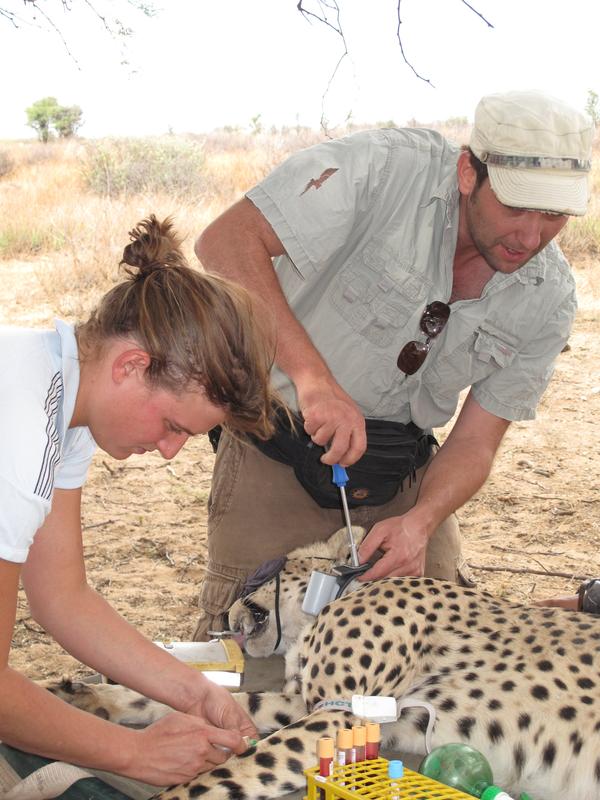How cheetahs stay fit and healthy

Sonja Heinrich taking blood samples and Jörg Melzheimer radio collaring an immobilised cheetah in Namibia. Bettina Wachter/Leibniz-IZW
Cheetahs have a relatively low genetic variability which means that, within a population, the individuals have a similar genetic makeup. This is also true for the major histocompatibility complex (MHC), a genome region that regulates the so-called “adaptive” immune system and is typically highly variable in animal species.
The adaptive immune system provides a rapid and specific defence against pathogens, if they have been encountered previously. A low MHC variability should therefore result in a weak adaptive immune system and thus a high vulnerability to diseases. This is often the case in species with low MHC variability, but there are some exceptions, the cheetah indeed being one of them.
“During our long-term study that begun in 2002, we investigated more than 300 free-ranging cheetahs that live on farmland in Namibia. We did not encounter any cheetah with symptoms of acute infections, nor did we detect lesions in the examined dead animals”, explains Bettina Wachter, head of the cheetah research project.
How can cheetahs cope so well with pathogens despite their supposedly weak adaptive immunity? The immune system is divided into three components:(1) the constitutive innate immune system, which provides a rapid first line of defence against intruders, (2) the induced innate immune system such as the local and systemic inflammatory response, which enhances recovery and decreases pathogen growth, and (3) the adaptive immune system.
“We decided to investigate all three components simultaneously, an approach that is rarely done although it is very promising. For every animal, a well-functioning immune system is associated with certain energetic costs. However, this does not imply that all immune components are equally strongly developed. If a species is not vulnerable to diseases, a good immune response must have evolved by strengthening other parts of the immune system”, says Gábor Czirják, wildlife immunologist at the Leibniz-IZW.
To compare the results with another species, the scientists included leopards in the study. “Leopards live in the same habitat as cheetahs in Namibia, but they have a high variability in their MHC. Thus, leopards should have a strong adaptive immune system and might not invest that much energy in the other parts of the immune system”, explains Wachter.
“We first needed to adapt six immunological tests from the toolbox of the wildlife immunology for the cheetah and leopard”, explains Sonja Heinrich, first author of the study. “We conducted these tests at the laboratory of the Leibniz IZW, thus needed to transport the samples we collected in Namibia all the way to Germany, keeping the cooling chain uninterrupted from the captured animal in the field to the Leibniz IZW”. The immunological tests confirmed that leopards have a stronger adaptive immune system than cheetahs, consistent with the differences in the MHC variability of both species. As expected, cheetahs had a stronger innate “first line of defense” immune system than leopards, thereby probably compensating their weak adaptive immune system.
The induced innate immune system reacts to pathogen intruders as well as to temporary stress. Therefore, the scientists also determined the concentration of the hormone cortisol, which activates catabolic processes and is increasingly released during stress. Although both species were exposed to the same capture and handling procedures leopards had significantly higher cortisol concentration in their blood than cheetahs, indicating that leopards reacted stronger to the examination methods. Thus, short-term stress might have stimulated the induced innate immune system, making it difficult to assess whether this immune part also helps to compensate the weak adaptive immune system of cheetahs, if the stress effect is not considered.
This is the first study in mammals demonstrating that different species spend varying efforts in the development of the different immune components. Cheetahs have apparently developed a way to successfully fight against pathogens despite their low genetic variability in their MHC. However, the future of this vulnerable species is highly uncertain because most of their habitat occurs in unprotected areas and they frequently come into conflicts with humans. Only if these conflicts can be mitigated, the cheetahs have a good chance to persist in the wild in the future.
Publication:
Heinrich SK, Hofer H, Courtiol A, Melzheimer J, Dehnhard M, Czirják GÁ, Wachter B (2017) Cheetah have a stronger constitutive innate immunity than leopards. Scientific Reports 7. www.nature.com/articles/srep44837.
Contact:
Leibniz Institute for Zoo and Wildlife Research(ZW)
in the Forschungsverbund Berlin e.V.
Dr. Bettina Wachter
wachter @izw-berlin.de
Tel.: + 49 – 30 – 51 68 – 518
Steven Seet
seet@izw-berlin.de
Unit Press & Communications
Tel.: + 49 – 30 – 51 68 – 125
Media Contact
More Information:
http://www.fv-berlin.deAll latest news from the category: Life Sciences and Chemistry
Articles and reports from the Life Sciences and chemistry area deal with applied and basic research into modern biology, chemistry and human medicine.
Valuable information can be found on a range of life sciences fields including bacteriology, biochemistry, bionics, bioinformatics, biophysics, biotechnology, genetics, geobotany, human biology, marine biology, microbiology, molecular biology, cellular biology, zoology, bioinorganic chemistry, microchemistry and environmental chemistry.
Newest articles

Innovative vortex beam technology
…unleashes ultra-secure, high-capacity data transmission. Scientists have developed a breakthrough optical technology that could dramatically enhance the capacity and security of data transmission (Fig. 1). By utilizing a new type…

Tiny dancers: Scientists synchronise bacterial motion
Researchers at TU Delft have discovered that E. coli bacteria can synchronise their movements, creating order in seemingly random biological systems. By trapping individual bacteria in micro-engineered circular cavities and…

Primary investigation on ram-rotor detonation engine
Detonation is a supersonic combustion wave, characterized by a shock wave driven by the energy release from closely coupled chemical reactions. It is a typical form of pressure gain combustion,…



